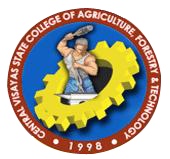



The road to success was by no means an easy one. BISU was actually the Central Visayas State College of Agriculture, Forestry, and Technology (CVSCAFT). It was originally composed of five (5) independent vocational and technical public schools in the province of Bohol, integrated by virtue of Republic Act 8659 signed on June 22,1998. The composite schools then were the following: The Bohol Agriculture College in Barangay Zamora, Municipality of Bilar; The Bohol School of Fisheries in Barangay Cogtong, Municipality of Candijay; The Clarin School of Fisheries in Barangay Poblacion, Municipality of Clarin; The Calape National School of Fisheries in Barangay Calunasan, Municipality of Calape and; The Bohol School of Arts and Trades (BSAT) in Tagbilaran City.
Republic Act 8659, the charter integration the five vocational technical schools into one CENTRAL VISAYAS STATE COLLEGE OF AGRICULTURE , FORESTRY AND TECHNOLGY, made the Bohol Agriculture College as the CVSCAFT-Main Campus and the rest as component campuses with “modicum administrative and financial autonomy to allow operational efficiency and effectiveness within the requirement of a harmonious and unified management of the integrated state college for optimum benefits from limitd resources”. It’s first President, Dr. Mateo M. Limbago together with Vice President for Acadamic Affairs, Dr. Louis T. Palapar, were installed shortly after the enactment of the law.

From humble beginnings, CSCAFT has grew into a promising state college with a dedicated personnel of 355 faculty members and support staff who are attending to a student population of 9,866 for the second Semester of Academic Year 2009-2010. Since her birth, she grew in size leadership and influence far beyond expectations in her multi-faceted curricular offerings. Her very strong linkage with the Local Government Units and National Government Agencies has dynamically enabled her to strategically meet the increasing demands and needs of a growing state college. She has consistency interlinked with may prestigious foreign universities and institutions offering collaborative assistance in raising the educational, technological and cultural standards through research works, extension and training programs and production activities.

As one of the leading institutions in Central Visayas, the CVSCAFT System served not only Boholanos but also those from the neighboring provinces in the Visayas and Mindanao. It continually produced graduates who became leaders in the community, managers and directors in many corporate organizations, experts and consultants in various technological fields, and administrators in educational institutions. She took pride in harnessing graduates who top board examinations, students under On-the-Jib Training (OJT) Programs who are absorbed directly by their cooperating companies and sent abroad further training and deployment, and other successful graduates who worked their way to prove true to the vision, mission, and goals of the institution, thus, making the differene.Today, Bohol Island State University is geared to pursue he culture of excellence cultivated by its proud past, guided by its mandate, and directed by its vision-mission.
